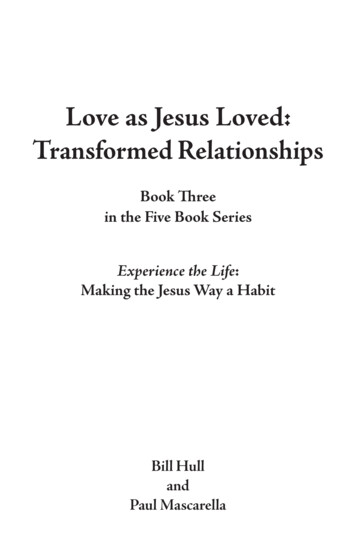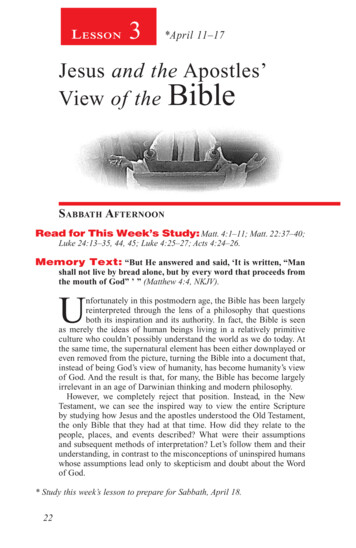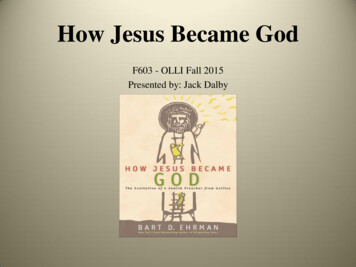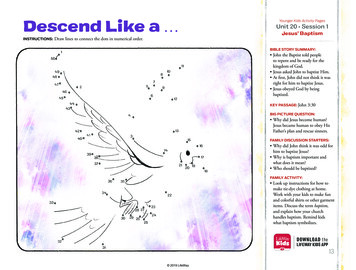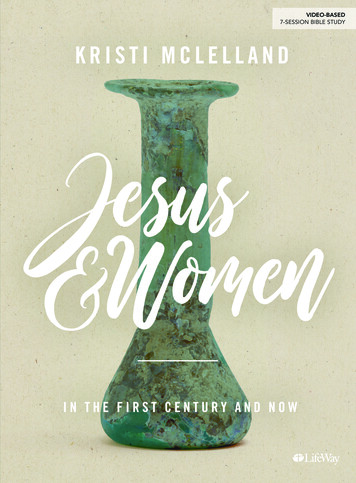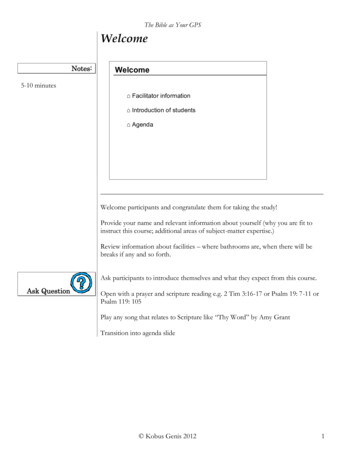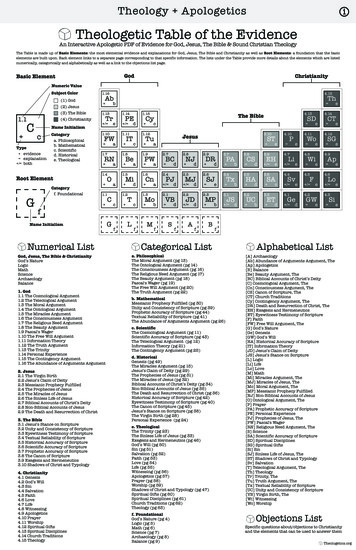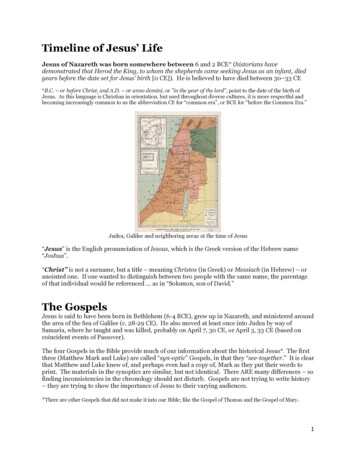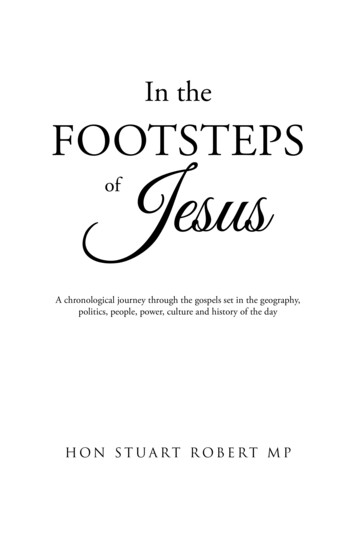
Transcription
In theFOOTSTEPSofJesusA chronological journey through the gospels set in the geography,politics, people, power, culture and history of the dayHON S T UA RT R OBE RT M P
Unless otherwise noted, all scripture is from the New English Translation(NET) Bible. This is a wonderful contemporary but rigorously exacttranslation that I know you will thoroughly enjoy reading.Within copyright statements or in discussion about the NET Bible, thefollowing is preferred: Scripture quoted by permission. Quotations designated(NET) are from the NET Bible copyright 1996-2016 by Biblical StudiesPress, L.L.C. http://netbible.org All rights reserved.The names: THE NET BIBLE , NEW ENGLISH TRANSLATIONCOPYRIGHT (c) 1996 BY BIBLICAL STUDIES PRESS, L.L.C. NETBible IS A REGISTERED TRADEMARK THE NET BIBLE LOGO,SERVICE MARK COPYRIGHT (c) 1997 BY BIBLICAL STUDIESPRESS, L.L.C. ALL RIGHTS RESERVED. SATELLITE IMAGERYCOPYRIGHT (c) RØHR PRODUCTIONS LTD. AND CENTRENATIONAL D‘ÉTUDES SPATIALES PHOTOGRAPHS COPYRIGHT(c) RØHR PRODUCTIONS LTD.ISBN 978-0-97575-671-3Published by the Honourable Stuart Robert MPCopyright 2017 Hon Stuart Robert MPCoverart:Miguel S. Kilantang JrCover design: Miguel S. Kilantang JrPhotographs: used by permission from the Hon Stuart Robert MPused by permission from the Library of Congress (public domain)front cover image is used by permission from istockphotos.comMaps:used by permission the American bible society 1888 (publicdomain)used by permission from God’s Word First InternationalBiblical Research and Teaching Ministryused by permission, J. T. Barclay ‘City of the Great King’ 1858(public domain)Edit:The Expert EditorPrinted in:CreatespaceComments: inthefootstepsofjesus@robert.com.au
To my amazing wife, Chantelle. Thank you for your patience in thisgreat gospel journey of discovery.To our three beautiful sons, Caleb, Isaac and Jacob. May you grow andlearn to love the Saviour of the world, Jesus, and the holy land of IsraelHe lived and died in, as much as we do.To readers young and old. May you walk through the gospel story ofJesus afresh and marvel at the scandal of grace that has been affordedto you.
ContentsPrologue .7Introduction .11Chapter 1 - The scarlet thread .17Chapter 2 - Time is split .42Chapter 3 - Inauguration .60Chapter 4 - Death threats .81Chapter 5 - Popularity .109Chapter 6 - Parables .141Chapter 7 - Opposition .176Chapter 8 - Transfiguration .204Chapter 9 - Travel diaries .235Chapter 10 - Jesus sets out for Jerusalem .263Chapter 11 - Triumphant entry .288Chapter 12 - Passover .325Chapter 13 - Crucifixion .366Chapter 14 - Resurrection.403Conclusion .423About the Author .425
PrologueMany have attempted to provide a chronology of the key events fromJesus’ life sourced from the four gospels. Early attempts, starting withthe ‘Diatessaron’ by the Assyrian Christian Tatian in the 2nd century erroneously tried to merge the gospels into a single narrative andremove repetition. Many subsequently tried and all ultimately failed.The gospel accounts of Jesus are too rich and varied to harmonise intoa simple, lone account.Though this is a single book, this chronological attempt does not resortto a single narrative. Every word of the gospels is included and putin a chronological order to try to build a flowing picture of Jesus’ lifeand ministry. It is important to note that every attempt, including thisone include leaps of logic, numerous assumptions and a few flat outguesses. Every attempt is cognisant of geography, archeology, historicaldocuments and the odd local legend. All are well meaning and thereis no conclusive proof that one chronological attempt is better thananother.The four gospels were written as different accounts to different audiences and there was never an attempt to harmonise them geographicallyor chronologically within the Bible. Jesus probably spoke in Aramaic,7
HON STUART ROBERTbut the gospels are written in Greek, which helps explains different versions of the same stories. Matthew, Mark and Luke are called ‘synoptic’gospels because they seek to present the events of Jesus’ life with thesame intent (synoptic literally means ‘together sight’). Nearly 90 percent of Mark’s content is found in Matthew, and 50 percent of Mark isin Luke. All of the parables of Christ are found in the synoptic gospels,whilst John’s gospel contains no parables (the vine and the branches inJohn 15:1-8 is not considered a parable). Some of the authors tended toarrange materially topically, which explains all of Jesus’ recorded miracles in Matthew being contained in just a few chapters. Jesus travelledextensively and used similar analogies and phrases to communicate Hismessage at different times, in much the same way itinerant preachersdo today. This explains why different gospels have similar content usedin different circumstances.What is refreshing about this clear lack of coordination and chronology, is that it is one of the best examples of the independence of thegospels. The differing accounts of the same activity and different orderthey appear in the gospels put to flight any criticism of gospel plagiarism from any ‘unnamed’ source.This book’s chronological attempt, however flawed, tends to follow theorder of the gospel of Luke. Luke was writing an historical account forhis benefactor and thus tended to be more concerned with timing ofevents. Luke was a doctor in his time and it’s fair to say that order was alittle more up his alley. He was also keen to emphasis Jesus’ compassionto Gentiles and Samaritans so that the travel diaries of Jesus in His finalmonths on earth (Luke 10-20) is largely unique to that gospel.Matthew was writing to a predominantly Jewish audience so his focuswas not necessarily logical but more spiritual. He quotes extensivelyfrom the Old Testament and his often-used phrase (in fact thirty-twotimes), ‘the kingdom of heaven’ is not found anywhere else in scripture.8
IN THE FOOTSTEPS OF JESUSBoth Luke and Mathew are also much longer than Mark’s gospel. Markwas writing from the teaching of Peter and to a predominantly Gentile(Roman) audience, so his account is fast paced, punchy and full ofactivity. A bit like Peter.John’s gospel is different again. Many of the important events in thesynoptic gospels are omitted: the temptation of Jesus, the sermon onthe mount, Jesus’ transfiguration, the Lord’s prayer and the institutionof communion (the Lord’s supper). You won’t find Jesus casting out ademon in John, yet only John mentions Jesus’ early Galilean ministry.In fact, it is John’s gospel that gives us the three year view of time inministry and the number of visits to Jerusalem. The synoptic gospelsappear to describe only one journey of Jesus to Jerusalem (the finalone), and concentrate predominantly on just one year of Jesus’ ministry in Galilee. John also tends to write in more dialogue and discourses,rather than statement of events, leading some to argue his gospel is amore reflective style of writing1.Suffice to say that every effort has been made to present the chronologyof the gospels with as much rigour as possible. Likewise every effort hasbeen made to present the dates accurately. All dates are based on thecrucifixion of Jesus on Friday 3rd April 33 AD (14th Nisan 3793 inthe Hebrew calendar). There are equally compelling arguments for thedate being Friday 7th April 30AD (16th Nisan 3790 in the Hebrewcalendar) however like the chronology, a timeline has to be chosen, sofor this book it is 33 AD.Please note that if there are errors, they are mine and mine alone andI apologise for them if they appear. My only caution is not to jump toconclusions too readily. Archaeological evidence seems compelling at1W. Hall Harris III is Professor of New Testament Studies at DallasTheological Seminary in etween-john-and-synoptic-gospels (accessed 22 Oct 2016)9
HON STUART ROBERTfirst until the fifth century piece of pottery turns up in the undisturbedpristine first century living room. Above all, enjoy the rollicking readof the greatest story every told. Jesus, the Son of God, through whomthe universe was made, came to earth to die for you and I to reconcileus back to God. Separated by the first man Adam, we are made rightwith our God because of the second Adam, Jesus.Hon Stuart Robert10
IntroductionThe Bible speaks of a scarlet thread woven through human history,in the form of the continuing theme of Jesus the Christ (Messiah)the Son of God. Beginning as the Creator of the world before timebegan, continuing through creation, walking in Eden, enduring thefall, coming as a baby, growing into a man and laying down His life asa final and complete sacrifice for all, Jesus was, is and always will be.The story of the scarlet thread is one like no other, because it beganbefore time. God the Father, Jesus the Son and the person of the HolySpirit, the triune nature of God has always been. Then they created us.That’s right, they created this world and all that is in it. They createdthe first man and woman, Adam and Eve, with the intent that theworld would be filled with people who know and love God. Peoplewho would know no sin, no shame, no guilt, no fear. A people inperfection.The problem, as it still often is, was people. Adam and Eve could dowhatever they wanted in the Garden of Eden except for one thing,just one, stay away from the tree of the knowledge of good and evil.History tells us that that one thing was one thing too many, and sinsubsequently entered the world through the first fruity bite. As sin11
HON STUART ROBERTentered, we became separated from that beautiful, perfect relationshipwith God. Shame, guilt and fear came flooding in where previouslyonly love, joy and peace resided.Yet even at that instant, God had already planned a path to restoreeveryone back to Him. A perfect path that would restore that perfectrighteous relationship. Except this time it would not be based on theknowledge of good and evil in the form of a tree, it would be basedon a perfect sacrifice to satisfy the righteous judgement of a perfectGod. God himself would step down from eternity in the form of Hisson Jesus, would live amongst us, would die amongst us and wouldrise again amongst us. We would be given the opportunity to chooseJesus as our path to eternal life, our restoration of the perfect righteousrelationship with God.All of this planned in an instant, and because God is omniscient(all-knowing), all of this was known in the beginning. Such perfectlove to create the universe knowing all this, to create our world knowing all this, to create us in His image knowing all this, to allow Adamand Eve to do that one thing knowing all this. Knowing all this, Godstill created.We know all this because of the inspired, innerant, infallible Word ofGod, the ‘Bible’, an incredible picture of the creation, fall and redemption of mankind. It is actually a book of sixty-six books written byforty authors on three continents in three languages over a period of2000 years. The authors ranged from princes to prophets, from shepherds to scholars, writing from palaces and prisons and everywherein between. They recorded history, recited poetry, delivered prophecy,offered proverbs, sang psalms, recorded laws and ultimately presentedgrace. It is a book of two covenants, ‘the old and the new’ one thatleads to death and one that leads to life. It is a book of law and of grace.The Old Covenant was handed down from God in the form of the12
IN THE FOOTSTEPS OF JESUSTen Commandments at Mount Sinai where 3000 people would die(Exodus 32:28). The New Covenant of Grace was purchased with theblood of Jesus and 3000 people would be saved the day the promisedHoly Spirit came at Pentecost on Mount Zion (Acts 2:41).The law was given on Mount Sinai but grace was given on MountZion.For you have not come to something that can be touched, to a burningfire and darkness and gloom and a whirlwind. But you have cometo Mount Zion, the city of the living God, the heavenly Jerusalem,and to myriads of angels, to the assembly. Hebrews 12:18 and 22Woven through all of this scripture like a scarlet thread is the personof Jesus Christ, the promised Messiah, the Son of God. Jesus appearsin the very first verse of the Bible (chronologically) John 1:1, “In thebeginning was the Word, and the Word was with God, and the Wordwas fully God”, and the end of the Bible in Revelation 22:20, “Yes, Iam coming soon”, and everywhere in between.It is this Jesus, the sinless Son of God, that was born as a man, lived asa man and died as a man to pay the penalty for our sin. It is this Jesusthat took our trespasses and gave us His right standing with God. It isthis Jesus that ushered in the New Covenant of Grace, of unmerited,undeserved, unfathomable favour upon the lives of all who believe inthe finished redemptive power of the cross. It is this Jesus that madeus completely righteous, not because of anything we did, but becauseof everything He did. It is this Jesus that crawled as a baby, walked as aman and died as a Saviour amongst us.Jesus lived on earth for just thirty-three years and travelled no morethan a couple of hundred kilometres in any direction. He lived at thetime of seemingly ultimate power, that of the Roman Empire, yet He13
HON STUART ROBERTdiscussed politics only once, when the issue of taxation was used to tryand trap him (Matthew 22:17-22). He penned no letters and left nomonuments, leaving that to His disciples and the church.The only recognised reliable account that exists of the Saviour of theWorld, the Son of God, Jesus the Christ, amongst us on earth is thefour gospels in the Bible named Matthew, Mark, Luke and John, aftertheir authors. Whilst there are numerous authenticating secular letters,the gospel accounts offer four unique and different pictures of Jesus,written to different audiences for different purposes. The gospels contain 64,766 words in total with each containing the same and differentstories. Of the almost 400 stories, events and accounts of Jesus in thegospels, very few accounts are contained in all four gospels, testimonyto their differences. The gospel of Mark doesn’t even contain the miracle of the birth of Jesus.The gospels are not chronological and at times contain differentaccounts of the same event, as if a number of people were witnesses buteach saw and concentrated on something unique in the same encounter. There is something endearingly human about different authorsfocussing their attentions on what they perhaps thought was the mostimportant facet within a certain event. That still doesn’t explain Mark’sgospel missing the virgin birth though! I must speak to him about thatwhen my race here on earth is run.There is such richness in the gospel accounts of Jesus, that bring theauthor and perfector of our faith to life (Hebrews 12:2). It is a storyunparalleled in the history of the world. A story of love so divine and ofgrace so deep that it deserves to be told in many different ways, as thegospels do so beautifully. The Bible will always be an open and flowingconversation with us today. If we want to find out what Jesus woulddo, go find out what He said. For Jesus doesn’t just bring life, He is lifeand the Bible brings this to our life.14
IN THE FOOTSTEPS OF JESUSIndeed one of the four gospels, that of Luke, was written for his benefactor, Theophilus, so that he would know the certainty of what he hadbeen taught.Now many have undertaken to compile an account of the thingsthat have been fulfilled among us,like the accounts passed on tous by those who were eyewitnesses and servants of the word fromthe beginning. So it seemed good to me as well, because I havefollowed all things carefully from the beginning, to write anorderly account for you, most excellent Theophilus, so that youmay know for certain the things you were taught. Luke 1:1-4Whilst there are thousands of books on the gospels and each has been ablessing, there is space for yet one more book to build on this certainty.A harmonised, chronologically presented gospel account of Jesus, set inthe geography, politics, people, power, culture and history of the day sothe reader can walk with Jesus over his thirty-three years as he crawled,walked and died on earth. This book is not meant as a commentary oran academic treatise, merely an opportunity to read every word of thefour gospels woven into the time and setting of the historical truth ofthe Saviour of the world.Professor Beitzel, the chief consultant for the amazing ‘Biblica’ BibleAtlas reinforces the values of such an approach, writing that where Jesuswas when He taught brings His message to life. “Jesus talks about living water while at Jacob’s well; He calls himself the bread of life while atCapernaum where basaltic grain mills were manufactured; and he talksabout faith that can move a mountain while on the road to Bethphage,from where His disciples could easily have looked southward and physically seen evidence of a mountain that had been moved by Herod theGreat in order to construct his fortress site of Herodium.”22Beitzel, B., ‘Biblica’ Barron’s Educational Services, USA, 2007, Foreward.15
CHAPTER 1The scarlet threadThere has never been a time when Jesus has not been with God theFather and the third person of the Godhead, the person of the HolySpirit. Jesus was there when our world was created, and more, everything was created through Him.In the beginning was the Word, and the Word was with God,and the Word was fully God. The Word was with God in thebeginning. All things were created by him, and apart from himnot one thing was created that has been created. In him was life,and the life was the light of mankind. And the light shines on inthe darkness, but the darkness has not mastered it. John 1:1-5This is literally the first verse of the Bible, the opening scene of ourhistory. It is the moment when the God of the universe commencedHis great act of creation that is recorded in the book of Genesis.Furthermore, this opening scene tells us that Jesus is the author of lifeand the light of mankind. It is through Jesus that we can see the truthof where we came from, where we’re going and how we’re going to getthere. That’s what light does – it illuminates the path.17
HON STUART ROBERTA witness to this light, a man named John the Baptist, was sent toannounce the coming of the Light of the world, Jesus. Chapter 3 willdiscuss the work of John in more detail, suffice to say he was the lastof the prophetic witnesses to Jesus as the light of the world. The lastprophet sent by God to herald the coming Jesus, and the first prophetto actually see Jesus.A man came, sent from God, whose name was John. He came as a witnessto testify about the light, so that everyone might believe through him.He himself was not the light, but he came to testify about the light. Thetrue light, who gives light to everyone, was coming into the world. Hewas in the world, and the world was created by him, but the world didnot recognize him. He came to what was his own, but his own peopledid not receive him. But to all who have received him-those who believein his name-he has given the right to become God’s children -childrennot born by human parents or by human desire or a husband’s decision,but by God. Now the Word became flesh and took up residence amongus. We saw his glory-the glory of the one and only, full of grace andtruth, who came from the Father. John testified about him and shoutedout, “This one was the one about whom I said, ‘He who comes afterme is greater than I am, because he existed before me.’” For we have allreceived from his fullness one gracious gift after another. For the lawwas given through Moses, but grace and truth came about through JesusChrist. No one has ever seen God. The only one, himself God, who is inclosest fellowship with the Father, has made God known. John 1:6-18Whilst Jesus was fully God, He was also born fully man in fulfilmentof the promise first given to Abraham and again to King David. Thus,Jesus has a human legal lineage through His earthly father Joseph thattraces right back to Abraham as listed in Matthew’s gospel. This lineagelists three lots of fourteen generations from Abraham to King David,King David to the final exile of the Israelites from Jerusalem and thenfrom the exile to the coming of Jesus. As an aside, there are only 4118
IN THE FOOTSTEPS OF JESUSnames in the list, yet three lots of fourteen is 42. This is awkward,until you explore a little deeper. Excluded from the list is Jehoiakim(also known as ‘Eliakim’), who was Josiah’s son and Jeconiah’s father (1Chronicles 3:15-16). The reason for his exclusion may be that he was apuppet king, given his rule by Pharaoh King of Egypt. The first phase ofthe captivity of Judah by Babylon began at the end of Jehoiakim’s reign,prior to his son Jeconiah coming into power. Thus, the three groupings of 14 generations would include Abraham to David, Solomon toJehoiakim (he is not mentioned, but was among the first to be carriedoff into Babylon) and Jeconiah to Jesus. This is the wonder of the treasure trove of the Bible. At almost every page there is fascinating history,hidden gems and profound truths.This is the record of the genealogy of Jesus Christ, the son of David,the son of Abraham. Abraham was the father of Isaac, Isaac the fatherof Jacob, Jacob the father of Judah and his brothers, Judah the fatherof Perez and Zerah (by Tamar), Perez the father of Hezron, Hezronthe father of Ram, Ram the father of Amminadab, Amminadab thefather of Nahshon, Nahshon the father of Salmon, Salmon the father ofBoaz (by Rahab), Boaz the father of Obed (by Ruth), Obed the fatherof Jesse, and Jesse the father of David the king. David was the fatherof Solomon (by the wife of Uriah), Solomon the father of Rehoboam,Rehoboam the father of Abijah, Abijah the father of Asa, Asa the fatherof Jehoshaphat, Jehoshaphat the father of Joram, Joram the father ofUzziah, Uzziah the father of Jotham, Jotham the father of Ahaz, Ahazthe father of Hezekiah, Hezekiah the father of Manasseh, Manassehthe father of Amon, Amon the father of Josiah, and Josiah the father ofJeconiah and his brothers, at the time of the deportation to Babylon.After the deportation to Babylon, Jeconiah became the father of Shealtiel,Shealtiel the father of Zerubbabel, Zerubbabel the father of Abiud,Abiud the father of Eliakim, Eliakim the father of Azor, Azor the fatherof Zadok, Zadok the father of Achim, Achim the father of Eliud, Eliudthe father of Eleazar, Eleazar the father of Matthan, Matthan the19
HON STUART ROBERTfather of Jacob, and Jacob the father of Joseph, the husband of Mary, bywhom Jesus was born, who is called Christ. So all the generations fromAbraham to David are fourteen generations, and from David to thedeportation to Babylon, fourteen generations, and from the deportationto Babylon to Christ, fourteen generations. Matthew 1:1-17The second account of Jesus’ genealogy in Luke’s gospel takes his humanlineage back to the first man, Adam, and his creator God. Consideringthe first part of this chapter states clearly that Jesus and God are one,this genealogy takes Jesus literally back to Himself in the Godhead.This genealogy however, goes back through the line of Mary, the birthmother of Jesus. Thus, it is the same as that for Joseph above, up toKing David where it diverges. Mary is from the line of King David’sson ‘Nathan’, born to Bathsheba, whilst Joseph is from the line of KingDavid’s son ‘Solomon’, also born to Bathsheba (1 Chron 3:5).He was the son (as was supposed) of Joseph, the son of Heli, the son ofMatthat, the son of Levi, the son of Melchi, the son of Jannai, the son ofJoseph, the son of Mattathias, the son of Amos, the son of Nahum, the sonof Esli, the son of Naggai, the son of Maath, the son of Mattathias, theson of Semein, the son of Josech, the son of Joda, the son of Joanan, theson of Rhesa, the son of Zerubbabel, the son of Shealtiel, the son of Neri,he son of Melchi, the son of Addi, the son of Cosam, the son of Elmadam,the son of Er, the son of Joshua, the son of Eliezer, the son of Jorim, theson of Matthat, the son of Levi, the son of Simeon, the son of Judah, theson of Joseph, the son of Jonam, the son of Eliakim, the son of Melea, theson of Menna, the son of Mattatha, the son of Nathan, the son of David,the son of Jesse, the son of Obed, the son of Boaz, the son of Sala, the sonof Nahshon, the son of Amminadab, the son of Admin, the son of Arni,the son of Hezron, the son of Perez, the son of Judah, the son of Jacob,the son of Isaac, the son of Abraham, the son of Terah, the son of Nahor,the son of Serug, the son of Reu, the son of Peleg, the son of Eber, theson of Shelah, the son of Cainan, the son of Arphaxad, the son of Shem,20
IN THE FOOTSTEPS OF JESUSthe son of Noah, the son of Lamech, the son of Methuselah, the son ofEnoch, the son of Jared, the son of Mahalalel, the son of Kenan, the son ofEnosh, the son of Seth, the son of Adam, the son of God. Luke 3:23b-38Thus, Jesus is indeed the promised King from the line of Abraham andKing David, both on His Father and Mother’s side. He is the 42ndgeneration from Abraham. It is interesting to note that the Israeliteswhen they came out of captivity also passed through 42 camps3, thelast being at the Jordan River, where Jesus would be baptised. This isthe beauty of the gospel account of Jesus that we will walk through.The scarlet thread begins in the Old Testament and points at everytwist and turn to the coming Messiah, Jesus. Whether it is in campsstayed at during the wilderness years or the number of fish Peter caughtat the end of John’s gospel, it all points to Jesus.Jesus proclaimed When Jesus was to be born, God sent His messenger angel, Gabriel,to Jerusalem, now under Roman occupation, to announce His coming. The question is, why Jerusalem? A little bit of history will start tounpack that question, for Jerusalem is one of the most controversial cities on earth. In the last 3000 years this city has been destroyed at leasttwice, besieged twenty-three times, attacked an additional fifty-twotimes, and captured and recaptured forty-four times.4 Christian andJewish history draw heavily upon the city, and Islam views Jerusalemas its the third holiest site (after Mecca and Medina) believing thatMohammed ascended to heaven from the city in the seventh century.Clearly there is something about this city.34http://www.betemunah.org/stages.html# Toc454392386 accessed on 7October 2016. Noting there is considerable dispute about this numberEric H. Cline ‘Jerusalem Besieged’ as reproduced at rusalem.html accessed on 7 October2016.21
HON STUART ROBERTIn the temporal, it is difficult to understand why Jerusalem has anyimportance. It does not lie on any major trade routes and there isno easily discernible reason why this city should be one of the mostsignificant places in the world. Geographically, Jerusalem lies at thecrest of a low range of hills, forty-eight kilometres inland from theMediterranean Sea. Turn east and you are confronted with the JudeanHills and a descending landscape that drops rapidly to the Dead Seathat sits at 427m below sea level, the lowest body of water on earth andcompletely undrinkable.The maps below, printed by the American Bible Society in 1888, showthe city of Jerusalem with its walls at the time of Jesus and the existingwalls built from 1537 to 1541 by Sultan Suleiman the Magnificentafter the Ottoman conquest of Israel. The topography of the land isalso displayed. It shows the northern and highest part of the city beingthe peak of Mount Moriah, that extends south as a ridge line, endingwhere the Kidron and Hinnom valleys meet. This is where the currentexcavations are occurring at the site of the ancient City of David. Theland fall from Mount Moriah, at 777 metres high, to the intersectionof the two valleys is 177 metres, with the valley floor being 600 metresabove sea level.22
IN THE FOOTSTEPS OF JESUSThe walls of Jerusalem in different times courtesythe American Bible Society 1888600 metres to the west of Mt Moriah at 772 metres is Mount Zion.At the time of Jesus the deep Tyropean Valley separated Mount Zionfrom Mount Moriah; today however, the valley is completely filledwith many layers of ruined city rubble from Jerusalem’s many destructions.5As will be discussed in the section on the Temple, almost half ofthe western retaining wall of the Temple Mount lies below the presentground level, because the wall started at the bottom of this ancientvalley. East of Mount Moriah across the Kidron Valley is the Mount of5http://www.templemount.org/moriah2.html accessed on 7 October201623
HON STUART ROBERTOlives which is 100 meters higher than Mount Zion or
son Jesus, would live amongst us, would die amongst us and would rise again amongst us. We would be given the opportunity to choose Jesus as our path to eternal life, our restoration of the perfect righteous relationship with God. All of this planned in an instant, and because God is omniscie


